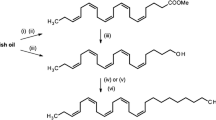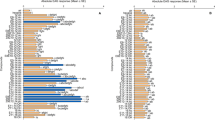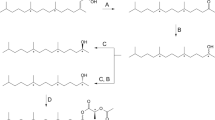Abstract
The ratio of two components in the sex pheromone of the potato tuberworm moth,Phthorimaea operculella, was influenced by the rearing temperature. The percentage of the (E,Z,Z)-4,7,10-tridecatrienyl acetate dropped as the rearing temperature was raised. The total amount of the pheromone did not change parallel with the change of ratio. The critical period sensitive to temperature seemed to be the pupal stage. Temperature in the larval stage may also influence the ratio slightly. The biological significance of the phenomenon was also discussed.
Similar content being viewed by others
References
Cardé, R.T. 1986. The role of pheromones in reproductive isolation and speciation of insects, pp. 303–317,in M.D. Huettel (ed.). Evolutionary Genetics of Invertebrate Behavior, Progress and Prospects. Plenum, New York.
Collins, R.D., andCardé, R.T. 1989. Selection for altered pheromone-component ratios in the pink bollworm moth,Pectinophora gossypiella (Lepidoptera: Gelechiidae).J. Insect Behav. 2:609–621.
Haynes, K.F., andHunt, R.E. 1990. A mutation in pheromonal communication system of cabbage looper moth,Trichoplusia ni.J. Chem. Ecol. 16:1249–1257.
Hunt, R.E., Zhao, B.-G., andHaynes, K.F. 1990. Genetic aspects of interpopulational differences in pheromone blend of cabbage looper moth,Trichoplusia ni.J. Chem. Ecol. 16:2935–2946.
Ono, T., andIto, M. 1989. Pattern of pheromone-oriented flight in male potato tuberworm moths.J. Chem. Ecol. 15:2357–2368.
Ono, T., andOrita, S. 1986. Field trapping of the potato tuber moth,Phthorimaea operculella (Lepidoptera: Gelechiidae), with the sex pheromone.Appl. Entomol. Zool. 21:632–634.
Ono, T., Charlton, R.E., andCardé, R.T. 1990. Variability in pheromone composition and periodicity of pheromone titer in potato tuberworm moth,Phthorimaea operculella (Lepidoptera: Gelechiidae).J. Chem. Ecol. 16:531–542.
Persoons, C.J., Voerman, S., Verwiel, P.E.J., Ritter, F.J., Nooyen, W.J., andMinks, A.K. 1976. Sex pheromone of the potato tuberworm moth,Phthorimaea operculella: Isolation, identification, and field evaluation.Entomol. Exp. Appl. 20:289–300.
Roelofs, W.L., andBrown, R.L. 1982. Pheromones and evolutionary relationships of Tortricidae.Annu. Rev. Ecol. Syst. 13:395–422.
Roelofs, W.L., Du, J.-W., Linn, C., Glover, T.J., andBjostad, L.B. 1986. The potential for genetic manipulation in the redbanded leafroller moth sex pheromone blend, pp. 263–272,in M.D. Huettel (ed.). Evolutionary Genetics of Invertebrate Behavior, Progress and Prospects. Plenum, New York.
Author information
Authors and Affiliations
Rights and permissions
About this article
Cite this article
Ono, T. Effect of rearing temperature on pheromone component ratio in potato tuberworm moth,Phthorimaea operculella, (Lepidoptera: Gelechiidae). J Chem Ecol 19, 71–81 (1993). https://doi.org/10.1007/BF00987472
Received:
Accepted:
Issue Date:
DOI: https://doi.org/10.1007/BF00987472




